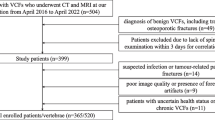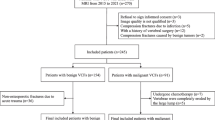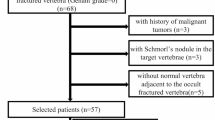Abstract
Objectives
To develop a deep-learning (DL) model for identifying fresh VCFs from digital radiography (DR), with magnetic resonance imaging (MRI) as the reference standard.
Methods
Patients with lumbar VCFs were retrospectively enrolled from January 2011 to May 2020. All patients underwent DR and MRI scanning. VCFs were categorized as fresh or old according to MRI results, and the VCF grade and type were assessed. The raw DR data were sent to InferScholar Center for annotation. A DL-based prediction model was built, and its diagnostic performance was evaluated. The DeLong test was applied to assess differences in ROC curves between different models.
Results
A total of 1877 VCFs in 1099 patients were included in our study and randomly divided into development (n = 824 patients) and test (n = 275 patients) datasets. The ensemble model identified fresh and old VCFs, reaching an AUC of 0.80 (95% confidence interval [CI], 0.77–0.83), an accuracy of 74% (95% CI, 72–77%), a sensitivity of 80% (95% CI, 77–83%), and a specificity of 68% (95% CI, 63–72%). Lateral (AUC, 0.83) views exhibited better performance than anteroposterior views (AUC, 0.77), and the best performance among respective subgroupings was obtained for grade 3 (AUC, 0.89) and crush-type (AUC, 0.87) subgroups.
Conclusion
The proposed DL model achieved adequate performance in identifying fresh VCFs from DR.
Key Points
• The ensemble deep-learning model identified fresh VCFs from DR, reaching an AUC of 0.80, an accuracy of 74%, a sensitivity of 80%, and a specificity of 68% with the reference standard of MRI.
• The lateral views (AUC, 0.83) exhibited better performance than anteroposterior views (AUC, 0.77).
• The grade 3 (AUC, 0.89) and crush-type (AUC, 0.87) subgroups showed the best performance among their respective subgroupings.





Similar content being viewed by others
Abbreviations
- AI:
-
Artificial intelligence
- AP:
-
Anteroposterior
- AUC:
-
Area under the curve
- BMEs:
-
Bone marrow edemas
- CNN:
-
Convolutional neural network
- DL:
-
Deep-learning
- DR:
-
Digital radiography
- LAT:
-
Lateral
- MRI:
-
Magnetic resonance imaging
- ROC:
-
Receiver operating characteristic
- VCFs:
-
Vertebral compression fractures
References
Beall DP, Chambers MR, Thomas S et al (2019) Prospective and multicenter evaluation of outcomes for quality of life and activities of daily living for balloon kyphoplasty in the treatment of vertebral compression fractures: the EVOLVE trial. Neurosurgery 84(1):169–178. https://doi.org/10.1093/neuros/nyy017
Musbahi O, Ali AM, Hassany H, Mobasheri R (2018) Vertebral compression fractures. Br J Hosp Med 79(1):36–40. https://doi.org/10.12968/hmed.2018.79.1.36
Goldstein CL, Chutkan NB, Choma TJ, Orr RD (2015) Management of the elderly with vertebral compression fractures. Neurosurgery 77(Suppl 4):S33–S45. https://doi.org/10.1227/NEU.0000000000000947
Petritsch B, Kosmala A, Weng AM et al (2017) Vertebral compression fractures: third-generation dual-energy CT for detection of bone marrow edema at visual and quantitative analyses. Radiology 284(1):161–168. https://doi.org/10.1148/radiol.2017162165
Löffler MT, Jacob A, Valentinitsch A et al (2019) Improved prediction of incident vertebral fractures using opportunistic qct compared to dxa. Eur Radiol 29(9):4980–4989. https://doi.org/10.1007/s00330-019-06018-w
Diekhoff T, Engelhard N, Fuchs M et al (2019) Single-source dual-energy computed tomography for the assessment of bone marrow oedema in vertebral compression fractures: a prospective diagnostic accuracy study. Eur Radiol 29(1):31–39. https://doi.org/10.1007/s00330-018-5568-y
Clark W, Bird P, Gonski P et al (2016) Safety and efficacy of vertebroplasty for acute painful osteoporotic fractures (VAPOUR): a multicentre, randomised, double-blind, placebo-controlled trial. Lancet 388(10052):1408–1416. https://doi.org/10.1016/S0140-6736(16)31341-1
Kaup M, Wichmann JL, Scholtz JE et al (2016) Dual-energy CT–based display of bone marrow edema in osteoporotic vertebral compression fractures: impact on diagnostic accuracy of radiologists with varying levels of experience in correlation to MR imaging. Radiology 280(2):510–519. https://doi.org/10.1148/radiol.2016150472
Frellesen C, Azadegan M, Martin SS et al (2018) Dual-energy computed tomography-based display of bone marrow edema in incidental vertebral compression fractures: diagnostic accuracy and characterization in oncological patients undergoing routine staging computed tomography. Invest Radiol 53(7):409–416. https://doi.org/10.1097/RLI.0000000000000458
Bierry G, Venkatasamy A, Kremer S, Dosch JC, Dietemann JL (2014) Dual-energy CT in vertebral compression fractures: performance of visual and quantitative analysis for bone marrow edema demonstration with comparison to MRI. Skeletal Radiol 43(4):485–492. https://doi.org/10.1007/s00256-013-1812-3
Zhao QM, Gu XF, Liu ZT, Cheng L (2016) The value of radionuclide bone imaging in defining fresh fractures among osteoporotic vertebral compression fractures. J Craniofac Surg 27(3):745–748. https://doi.org/10.1097/SCS.0000000000002594
Milby AH, Ughwanogho E, Hebela NM, Smith HE (2018) Vertebral compression fractures. In: Pignolo R, Ahn J (eds) Fractures in the elderly. Humana Press, Cham, p 195–206. https://doi.org/10.1007/978-3-319-72228-3_11
McKinney SM, Sieniek M, Godbole V et al (2020) International evaluation of an AI system for breast cancer screening. Nature 577(7788):89–94. https://doi.org/10.1038/s41586-019-1799-6
Zheng Q, Shellikeri S, Huang H, Hwang M, Sze RW (2020) Deep learning measurement of leg length discrepancy in children based on radiographs. Radiology 296(1):152–158. https://doi.org/10.1148/radiol.2020192003
Zhang R, Tie X, Qi Z et al (2021) Diagnosis of coronavirus disease 2019 pneumonia by using chest radiography: value of artificial intelligence. Radiology 298(2):E88–E97. https://doi.org/10.1148/radiol.2020202944
Wehbe R, Sheng J, Dutta S et al (2020) DeepCOVID-XR: an artificial intelligence algorithm to detect COVID-19 on chest radiographs trained and tested on a large US clinical dataset. Radiology 299(1):E167–E176. https://doi.org/10.1148/radiol.2020203511
Rauschecker AM, Rudie JD, Xie L et al (2020) Artificial intelligence system approaching neuroradiologist-level differential diagnosis accuracy at brain MRI. Radiology 295(3):626–637. https://doi.org/10.1148/radiol.2020190283
Adela A, Rangarajan L (2020) Computational techniques to segment and classify lumbar compression fractures. Radiol Med 125(6):551–560. https://doi.org/10.1007/s11547-020-01145-7
Al Arif S, Knapp K, Slabaugh G (2018) Fully automatic cervical vertebrae segmentation framework for X-ray images. Comput Methods Programs Biomed 157:95–111. https://doi.org/10.1016/j.cmpb.2018.01.006
Burns JE, Yao J, Summers RM (2017) Vertebral body compression fractures and bone density: automated detection and classification on CT images. Radiology 284(3):788–797. https://doi.org/10.1148/radiol.2017162100
Zhao S, Wu X, Chen B, Li S (2021) Automatic vertebrae recognition from arbitrary spine MRI images by a category-Consistent self-calibration detection framework. Med Image Anal 67:101826. https://doi.org/10.1016/j.media.2020.101826
Spiegl UJ, Beisse R, Hauck S, Bühren V (2009) Value of MRI imaging prior to a kyphoplasty for osteoporotic insufficiency fractures. Eur Spine J 18(9):1287–1292. https://doi.org/10.1007/s00586-009-1045-2
Neuhaus V, Lennartz S, Abdullayev N et al (2018) Bone marrow edema in traumatic vertebral compression fractures: diagnostic accuracy of dual-layer detector CT using calcium suppressed images. Eur J Radiol 105:216–220. https://doi.org/10.1016/j.ejrad.2018.06.009
Genant HK, Jergas M (2003) Assessment of prevalent and incident vertebral fractures in osteoporosis research. Osteoporos Int 14(Suppl 3):S43-55. https://doi.org/10.1007/s00198-002-1348-1
Dewar C (2015) Diagnosis and treatment of vertebral compression fractures. Radiol Technol 86(3):301–320
Selvaraju RR, Cogswell M, Das A, Parikh D, Batra D (2020) Grad-CAM: visual explanations from deep networks via gradient-based localization. Int J Comput Vision 128(2):336–359. https://doi.org/10.1007/s11263-019-01228-7
Domiciano DS, Figueiredo CP, Lopes JB et al (2013) Vertebral fracture assessment by dual X-ray absorptiometry: a valid tool to detect vertebral fractures in community-dwelling older adults in a population-based survey. Arthritis Care Res (Hoboken) 65(5):809–815. https://doi.org/10.1002/acr.21905
van der Velde R, Ozanian T, Dumitrescu B et al (2015) Performance of statistical models of shape and appearance for semiautomatic segmentations of spinal vertebrae T4–L4 on digitized vertebral fracture assessment images. Spine J 15(6):1248–1254. https://doi.org/10.1016/j.spinee.2015.02.018
Samelson EJ, Christiansen BA, Demissie S et al (2011) Reliability of vertebral fracture assessment using multidetector CT lateral scout views: the Framingham Osteoporosis Study. Osteoporos Int 22(4):1123–1131. https://doi.org/10.1007/s00198-010-1290-6
Kim YM, Demissie S, Genant HK et al (2012) Identification of prevalent vertebral fractures using CT lateral scout views: a comparison of semi-automated quantitative vertebral morphometry and radiologist semi-quantitative grading. Osteoporos Int 23(3):1007–1016. https://doi.org/10.1007/s00198-011-1774-z
Fuerst T, Wu C, Genant HK et al (2009) Evaluation of vertebral fracture assessment by dual X-ray absorptiometry in a multicenter setting. Osteoporos Int 20(7):1199–1205. https://doi.org/10.1007/s00198-008-0806-9
Grados F, Fechtenbaum J, Flipon E, Kolta S, Roux C, Fardellone P (2009) Radiographic methods for evaluating osteoporotic vertebral fractures. Joint Bone Spine 76(3):241–247. https://doi.org/10.1016/j.jbspin.2008.07.017
Genant HK, Delmas PD, Chen P et al (2007) Severity of vertebral fracture reflects deterioration of bone microarchitecture. Osteoporos Int 18(1):69–76. https://doi.org/10.1007/s00198-006-0199-6
Acknowledgements
The authors are grateful to American Journal Experts (AJE) for their assistance with language editing.
Funding
This study was supported by the Kuanren Talents Program of the Second Affiliated Hospital of Chongqing Medical University (2020–7).
Author information
Authors and Affiliations
Corresponding author
Ethics declarations
Guarantor
The scientific guarantor of this publication is Dajing Guo.
Conflict of interest
The authors of this manuscript declare relationships with the following companies: Infervision.
Statistics and biometry
Infervision kindly provided statistical advice for this manuscript.
One of the authors has significant statistical expertise.
Informed consent
Written informed consent was not required for this study because this was a retrospective study.
Written informed consent was waived by the Institutional Review Board.
Ethical approval
Institutional Review Board approval was obtained.
Methodology
• retrospective
• cross-sectional study/diagnostic or prognostic study/observational
• performed at one institution
Additional information
Publisher’s note
Springer Nature remains neutral with regard to jurisdictional claims in published maps and institutional affiliations.
Supplementary Information
Below is the link to the electronic supplementary material.
Rights and permissions
About this article
Cite this article
Chen, W., Liu, X., Li, K. et al. A deep-learning model for identifying fresh vertebral compression fractures on digital radiography. Eur Radiol 32, 1496–1505 (2022). https://doi.org/10.1007/s00330-021-08247-4
Received:
Revised:
Accepted:
Published:
Issue Date:
DOI: https://doi.org/10.1007/s00330-021-08247-4




